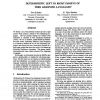325 search results - page 1 / 65 » MIX Is Not a Tree-Adjoining Language |
ACL
2012
11 years 7 months ago
2012
The language MIX consists of all strings over the three-letter alphabet {a, b, c} that contain an equal number of occurrences of each letter. We prove Joshi’s (1985) conjecture ...
ACL
1990
13 years 6 months ago
1990
We define a set of deterministic bottom-up left to right parsers which analyze a subset of Tree Adjoining Languages. The LR parsing strategy for Context Free Grammars is extended ...
ACL
1998
13 years 6 months ago
1998
Several methods are known for parsing languages generated by Tree Adjoining Grammars (TAGs) in O(n 6) worst case running time. In this paper we investigate which restrictions on T...
COGSCI
2004
13 years 4 months ago
2004
Disfluencies include editing terms such as uh and um as well as repeats and revisions. Little is known about how disfluencies are processed, and there has been next to no research...
IJCAI
2001
13 years 6 months ago
2001
In this paper, we present a quantitative comparison between the syntactic structures of three languages: English, Chinese and Korean. This is made possible by first extracting Lex...

